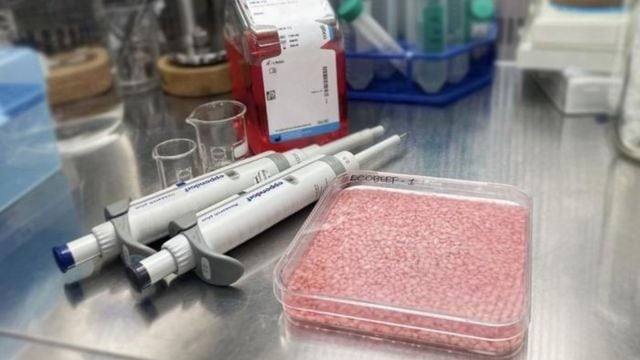Researchers grow beef cells in rice grains to create nutritious, hybrid food
Researchers in Korea have grown a culture of animal meat and fat inside a "scaffold" of rice, creating what they hope could be an eco-friendly and cheaper alternative to meat.
 Cow muscle and fat cells cultured in rice to create a hybrid food. (Yonsei University)
Cow muscle and fat cells cultured in rice to create a hybrid food. (Yonsei University) Scientists in Korea are working on creating “cultured beef rice” by growing animal muscle and fat cells inside rice grains. They presented their method on Wednesday and hopes to use it to create a nutritious and flavourful hybrid food that could become a more affordable protein with a smaller carbon footprint.
“Imagine obtaining all the nutrients we need from cell-cultured protein rice. Rice already has a high nutrient level, but adding cells from livestock can further boost it,” said Sohyeon Park, first author of an article published in the journal Cell Press, in a press statement.
Animal meat has biological “scaffolds” that help guide and support cells growth in three dimensions to make tissue and organs. The researchers mimicked this cellular environment using rice. Since rice grains are porous and have organised structures, they provide a solid “scaffold” to house animal-derived cells. Some molecules found in rice can also promote the growth of these cells.
They began by coating the rice with fish gelatin, which helps the cells lock to the rice better. They then seeded cow muscle and fat stem cells and left it to culture in a petri dish for nine to 11 days. The final product they got is a cell-cultured “beef rice:” with ingredients that meet food safety requirements, according to Yonsei University.
To see how the “rice” would fare as food, the researchers steamed and performed some food industry tests for nutritional value, odour and texture. They found that the new hybrid rice has eight per cent more protein and 7 per cent more fat then regular rice. It was also firmer and brittle compared to the sticky and soft texture. The rice with higher muscle content had beef and almond-like odour compounds while those with a higher fat content had compounds that corresponded to cream, butter and coconut oil.
“We usually obtain the protein we need from livestock, but livestock production consumes a lot of resources and water and releases a lot of greenhouse gas,” added Park, hoping that the hybrid rice can be a commercially viable and eco-friendly alternative to meat.







